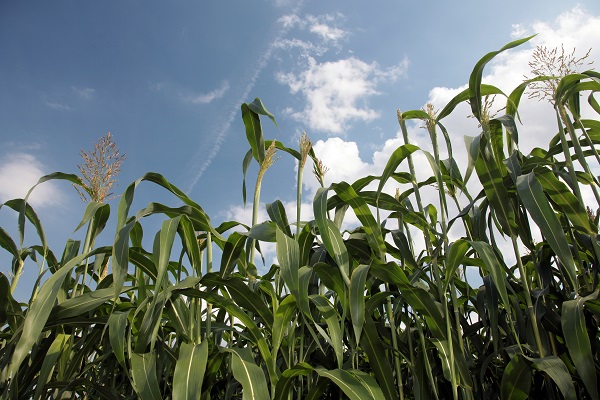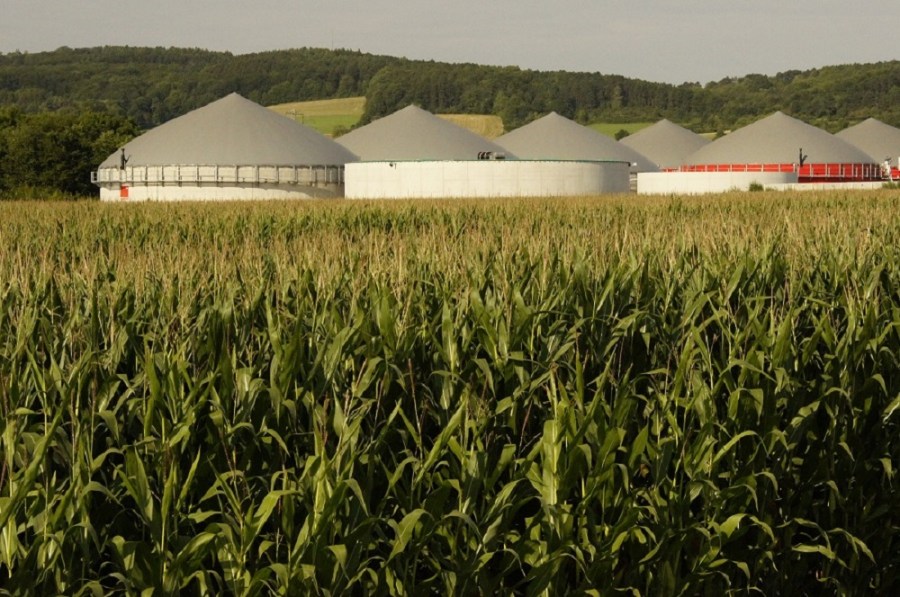Growing crops for anaerobic digesters is enjoying a surge in interest. CPM visits KWS’s maize headquarters to find out the key factors worth considering when growing for gas.
Growing crops for biogas needs as much thought, planning and husbandry expertise as cropping for food.
By Charlotte Cunningham
Growing crops for biogas has increased in popularity in recent years, largely due to the uptake of Feed in Tarriff (FiT) and Renewable Heat Incentives (RHI) schemes, with the industry in the UK now largely at full deployment.
Growers producing contract feedstock for nearby plants as a source of additional income alongside traditional combinable crops, has consequently placed energy crops as a key part of some arable rotations.

Yield response in energy maize is highest with later varieties (above FAO 200).
To feed an AD plant, high output feedstock crops are required, however, growing crops for energy — rather than for food — has led to problems with reduced methane yield and poor usage of available land. “Continental experience shows clearly that the selection and growing of crops for biogas needs as much careful thought, planning and husbandry expertise as cropping for food,” explains John Burgess, maize product manager and energy specialist at KWS.
According to KWS, yield is the overriding consideration for efficient energy crop production. “The key is to use a feedstock mix that allows the digestion process to function effectively, and maximise methane output, given the size, layout and capability of the operation,” he adds. “The digestion rate of different feedstocks within a biodigester varies from two days to two months. Material that has a high level of sugar or starch is quicker to ferment than feedstocks which have more lignin or cellulose.”
Therefore, material like energy beet will have a shorter retention time in the digester and release more gas over a shorter period of time than wholecrop cereals or maize. However, in terms of total methane yield; both wholecrop cereals and maize, while slower to release gas, can be just as effective as energy beet.
Energy maize, energy beet and hybrid rye are arguably three of the most popular crops to grow, but what should producers consider before planning to grow for gas?
Maize
Thanks to its high fresh yield potential and fairly straightforward cultivation, maize has become one of the main feedstocks for farm-based of biogas plants.
“The benefits of growing maize for gas include high dry matter (DM) yields, low cost per tonne, the ability to be grown continuously in the rotation, a high yield potential on lighter land and of course, high biogas yields,” explains John. “However, energy maize does need to be balanced with other crop substrates to encourage quicker retention time and there are concerns over the later harvest window and the increased risk of compaction and soil damage that comes with that.”
Though not yet publicly available, KWS is currently working on a project which aims to improve the ability for growers to monitor dry matter using satellite imagery and an app.
“An area in which we are constantly trying to innovate is monitoring dry matter in maize,” explains John. “How you monitor dry matter in maize has been subject to constant debate over the years, largely due to the level of inaccuracy.”
Trying to gauge where a crop is in terms of an average dry matter is nearly impossible unless you walk the entire field — which across hundreds of hectares is very time consuming, he adds. “The aim of the new Sat DM Monitoring app is to make farmer workload slightly easier, and the idea with this system is to look at the crop from a birds eye view using satellite technology.”
Using a satellite has quite a number of benefits in terms of giving growers a view from above and facilitating the generation of coloured maps which indicate DM explains John. “The benefit of this is being able to see the variation in DM on a per field basis, with the ability to zoom in to about 10m².”
On a practical scale, this means farmers have much more control over their crop, he adds. “Farmers will be able to make decisions much more accurately and therefore make a crop as financially rewarding as possible, not only by pin pointing precise DM stages, but also enabling them to organise workload better and prioritise which fields need cutting first.”
Key considerations for energy maize:
- Yield response is highest with later varieties (above FAO 200)
- Energy maize suits lighter soils and earlier drilling – drill deeper into moisture if needed
- Earlier varieties will have a fast dry-down at harvest leading to an increased dry matter %
- There is an increased risk of lodging/plant competition with late varieties (FAO <240), so ensure you select an appropriate variety split for your conditions.
KWS recommended AD maize hybrids:
Autens (FAO 170)
- Faster dry down with good standing power
- Full cob sheath coverage
- Top DM yield in its class
Keops (FAO 210)
- Rapid early vigour
- Ideal for spreading harvest or drilling window
- Heavy yield potential
Amaroc (FAO 240)
- Rapid early vigour
- Ideal for spreading harvest or drilling window on lighter land
- High volume plant type
Energy beet
Energy beet is one of the most efficient crops by land area, in terms of both methane output and sustainability.
Unlike maize — which can be slightly temperamental in terms of where it can be grown— energy beet is suitable for cultivation across most of the UK. “Energy beet has consistently high DM yield, very fast biodigestion, a proven history of agronomic knowledge and incredibly clean, high methane yields — it’s almost like a Red Bull for a digester,” explains Ben Bishop, sugar beet manager at KWS.
However, the relatively high production and processing costs should be considered before sowing, he adds. “Energy beet also requires quite a wide rotational position and growers should think carefully when it comes to storage as extra care needs to be taken when it comes to clamping.”
An area that requires particular attention is disease control — specifically virus yellows, adds Ben. “We haven’t talked about virus yellows for a number of decades because we’ve had neonicotinoids on our side, however, with the active no longer available we’re having to think differently about managing risk.
“There is tolerant material available to breed into our seed, so that is something we’re focusing on at present. However, for now, cultural controls are incredibly important for successfully growing energy beet.”
Though the maize-monitoring software is unlikely to be available until 2022, KWS do have a new Leaf Scanner app which is available on both Apple and Android devices.
The app allows users to take a picture from their smartphone and automatically recognises the five most important diseases, as well as providing the probability of how likely it is to be said disease.
In addition, the app provides information on how to treat the disease as well as advising on control measures and favourable environmental factors for each disease.
Key considerations for energy beet:
- Almost all — 95% — of the complete beet plant can be converted into biogas and the fermentation takes less than 14 days, making it an ideal partner for maize
- As with fodder or sugar beet, a minimum three-year rotation is advisable
- A robust soil management plan will be necessary in order to reduce the impact of structural damage
- To achieve maximum dry matter yield, aim to achieve a stand density of 85,000-100,000 plants/ha, using a seed rate of 11,000 seeds/ha.
KWS recommended AD beet:
Beretta
- High beet yield
- Robust disease resistance
- Low dirt tares
Alisha
- High sugar content (18.2%)
- Healthy canopy later in the season
- Rhizomania resistant
Eloquenta
- High DM yield
- Good gas yields/ha
- Low dirt tares
Hybrid rye
With high yields, a later drilling potential and the ability to act as a winter cover crop, hybrid rye has cemented itself as a firm favourite with those growing for AD. “Over the past few years, we’ve sown a lot more hybrid rye than ever before,” explains John. “While most of this is admittedly for grain, there is still a very prevalent case for wholecrop.”
When it comes to drilling rye, drilling depth is a key area to focus on, he adds. “It’s always important not to drill too deep. Rye has a very weak coleoptile, and if you drill too deep you can stretch it and eventually run into problems.”
To get the best out of the crop, a very short chop length is also required, adds John, so ensuring you have a forager — or at least access to a forager — that allows this consistency and quality is key.
With more varieties suited to grain rather than solely AD, has have been investing in research, looking at the value of crimped grain compared to silage. “Crimping has several benefits including producing a higher starch and ME content as a co-feedstock, as well as lower DM losses compared to silage,” explains John. “However, it’s important to be aware that feed-out rates are lower compared to wholecrop silage and the digestate produced has a higher DM percentage.”
HEAD: Key considerations for rye:
- Maximum yields come from regions with higher rainfall and heavier soils
- Early harvesting when the crop is at 30-35% dry matter produces the best gas yields
- Brown rust is the main leaf disease that will affect rye — between one and three fungicide applications may be required
- Hybrid varieties offer higher yields than conventional and KWS have achieved 38-45t/ha DM yields in the UK.
KWS recommended AD hybrid rye:
Eterno
- 2 in 1 hybrid
- Good brown rust resistance
- Top harvest index for grain or wholecrop yield
Propower
- Dedicated hybrid solely for AD
- High wholecrop yields (over 45t/ha)
- Biogas yield per tonne similar to maize (200m3)
Edmondo
- Dual purpose — suitable for AD or grain
- Good stem stiffness and disease resistance
- High yielding




